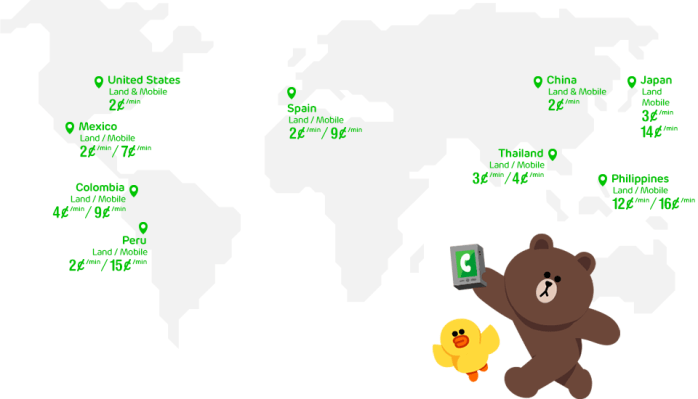In the ongoing battle for more users and differentiation between messaging apps, today Japan’s LINE has launched its newest feature: a flat-rate voice calling service called LINE Call. It expands on an already existing feature in LINE that let users call each other free via the app. Users will be able to keep their own mobile numbers for LINE Call — although “phone numbers may not be displayed correctly in some regions,” LINE notes.
The first people to get LINE Call will be Android users in eight markets — Colombia, Japan, Mexico, Peru, the Philippines, Spain, Thailand, and the U.S., who can download version 4.1.0 to access the service. The idea will be to expand that to more platforms and more countries over time.
As you can see from the diagram that Line has published listing pricing for the service, it looks like China will soon be turned on as well. Prices for landline calls start at 2 cents per minute (the US, Mexico, Peru, Spain and China when it comes on there get this cheaper rate) and progress up to 12 cents per minute (that’s in the Philippines). Mobile calls range from 4 cents through to 15 cents per minute.
The introduction of LINE Call — first announced in February but only turned on today — helps LINE compete better against the likes of Skype and Google for cheap in-app calls using mobile data instead of users’ voice minutes.
But it also is a way for LINE to offer an expanded service compared to its more immediate messaging competitors. Line, as of February, had 340 registered million users, without specifying how many of them are active. Messaging app leader WhatsApp, which was acquired by Facebook in Feburary for $19 billion, in the same month said the number of active users of its app had passed 465 million.
In February, WhatsApp also announced that it, too, would soon be offering voice calls but it has yet to reveal the details of what this will entail.
However, WhatsApp did also say at the same time that it would soon be unveiling a new, groundbreaking deal with E-Plus in Germany. As with the voice service, it gave no more details on this, but one possibility is that whatever WhatsApp tackles in its voice service could see it more closely link up with carriers. To be clear, WhatsApp has often worked with carriers in the past on mobile data bundles.
LINE notes that it is offering users two ways of paying for calls, either via call credits that you pre-pay for in advance (similar to Skype), or with 30-day voice plans that entail a fixed number of minutes for each month, which will work out as less expensive if you plan to use it a lot.
It’s another revenue-generating service that could help further boost the economic prospects for LINE, which made $156 million in revenues last quarter, $120 million of that from its core product, the LINE messaging app.
In 2013, reports surfaced that LINE was considering an IPO this year. It’s not the only Asian messaging giant that is gearing up for the public markets, apparently. Korea’s Kakao and Sina Weibo are also apparently in play to list soon.
